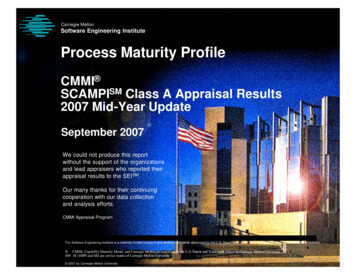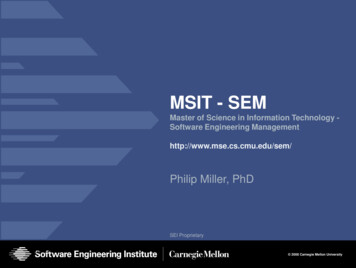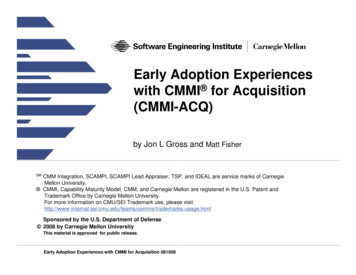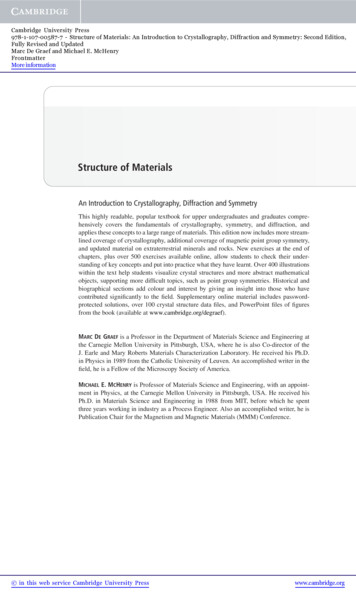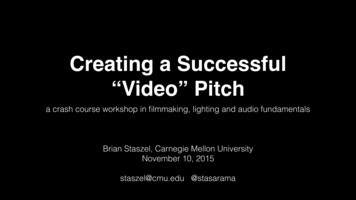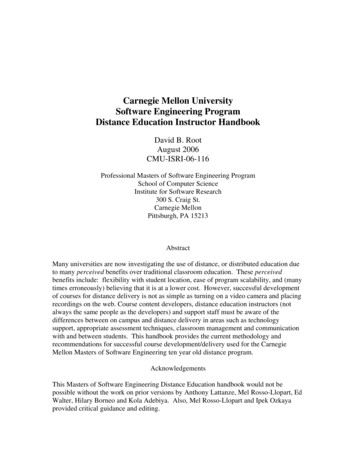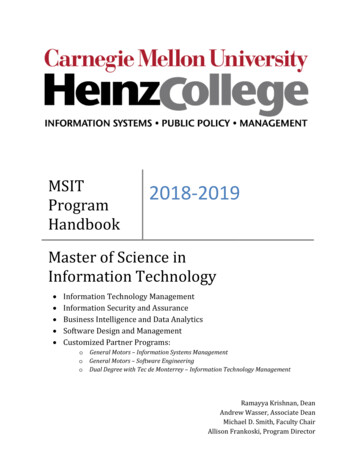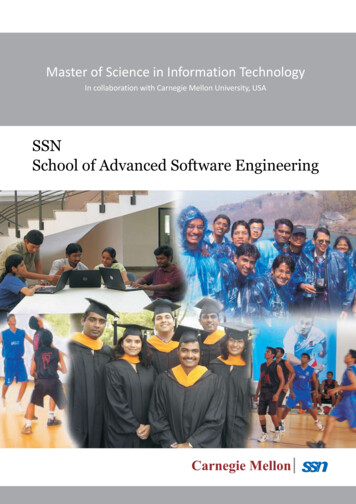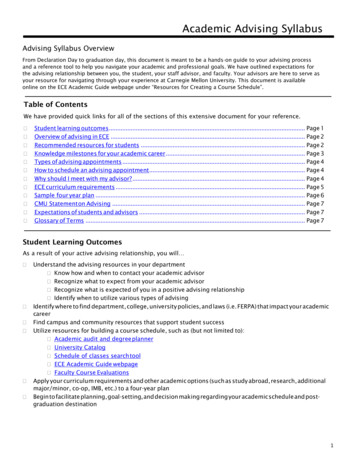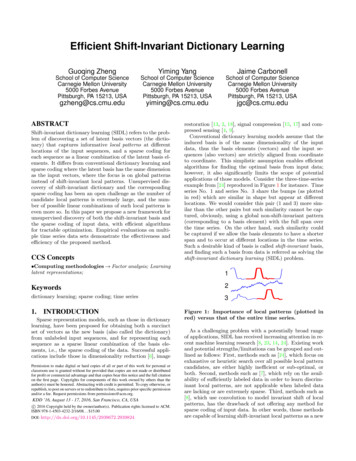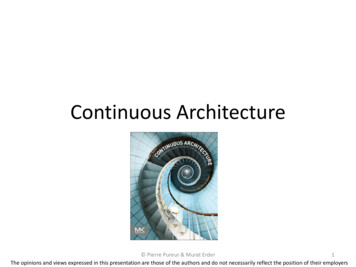
Transcription
Continuous Architecture Pierre Pureur & Murat Erder1The opinions and views expressed in this presentation are those of the authors and do not necessarily reflect the position of their employers
Outline Context – Brief History and WhyContinuous Architecture Principles1.2.3.4.5.6. Architect Products – not solutions for ProjectsFocus on Quality Attributes – not on Functional RequirementsDelay Design Decisions Until They Are Absolutely Necessary To Keep The ArchitectureManageableLeverage “The Power Of Small” To Architect For ChangeArchitect for Build, Test and Deploy To Deliver Capabilities ContinuouslyModel The Organization Of Your Teams After The Design Of The System To PromoteInteroperabilityBrief Case StudySome Thoughts on Modernizing Monolithic SystemsConclusion: Why does Continuous Architecture Work? Pierre Pureur & Murat Erder2
Context - Brief HistoryMainframes1950s PCs1970s Client Server1980s Smalltalk-801980Oracle V5– one of the firstRDBs to operate in clientserver mode 1985Arpanet migrated toTCP/IP 1983TechnologyJava 1.01995Hadoop2005OpenSource Initiative1998World Wide Web1990s SOAP1998Cloud2000s DevelopmentApproachSEI CMM1993Use Cases1992Agile Manifesto2001Continuous Delivery2011SAFE2012Design Patterns1995ContinuousArchitectureNow?4 1 Model on WebServices2006OSI Model (7 Layer)1984TOGAF 8.02003Zachman Framework1987 Pierre Pureur & Murat ErderTOGAF 9.120113
Context - A Few Thoughts Why do we even architect – why not just get on withsome quick design and a few sprints ? What is architecture?– A bag full of tools and the knowledge on when to usethemDancing House by Frank Gehry and– The ability to abstract at the correct level to make andVlado Milunic in Praguecommunicate the right decision– The ability to plan ahead beyond the current project, phase, iteration The basics tenets of good architecture have not changed. What hasevolved is the technology landscape– Increased ability to work at larger scale and in a distributed manner– Desire for quicker delivery timelinesWhat has not changed is the organizational hurdles that are the same as in GreekAntiquity Pierre Pureur & Murat Erder4
Overview: What is Continuous Architecture? The current trend in the industry is away from traditional Enterprise Architecture. We do notbelieve that the pendulum will swing back to traditional EA, and there is a need for an architecturalapproach that can encompass Continuous Delivery, providing it with a broader architecturalperspective. We call this approach “Continuous Architecture”. This is about using the appropriate tools to makethe right decisions and support Continuous Delivery, Continuous Integration and Continuous Testing. “Continuous Architecture” is an approach based on a toolbox – not a formal process!Continuous Architecture Principles1.2.3.4.5.6.Continuous Architecture Tool BoxArchitect Products – Not Just Solutions forProjects.Focus on Quality Attributes – not on FunctionalRequirements.Delay design decisions until they are absolutelynecessary.Architect for Change – Leverage “The Power ofSmall”.Architect for Build, Test and Deploy.Model the organization of your teams after thedesign of the system you are working on.Your SelectLocation Pierre Pureur & Murat Erder5
OverviewContinuous Architecture (CA) Goals To create an architecture that canevolve with applications, thatis testable, that can respond tofeedback and in fact is driven byfeedback To make Enterprise Architecture real To make solution architecturesustainable To create real world, actionable,useful strategies Pierre Pureur & Murat Erder6
Continuous Architecture Principles1.Architect Products – notsolutions for Projects6. Model theOrganization of yourTeams after theDesign of the SystemYou are Working on2.3.5. Architect for Build, Test and DeployAnalysis &DesignAgile IterationsCentralized QAIT OperationsIntegration & QADeploy & ReleaseThe “Last Mile”DevelopmentDelay Design Decisionsuntil They are AbsolutelyNecessaryTesting &ShowcaseAgile TeamBusinessPartnerFocus on Quality Attributes –not on FunctionalRequirements4. Architect for Change –Leverage “The Powerof Small” Pierre Pureur & Murat Erder7
CA Principle 1: Architect Products – Not Just Solutions For Projects It is all about focus: Solution Architecture vs.Enterprise Architecture Projects rarely exist in isolation – they are often part ofa “Software Product” What is a Software y– This concept forces IT shops to think differently about how they are delivering software– Think about your apps like a commercial software company What is Product Management?–Focus on stakeholders, not on plans or budgets Pierre Pureur & Murat Erder8
What Exactly is Product Management? The concept of product management has been in the industry fordecades and focuses on the success of introducing and maintaininga successful commercial product for an nologyProduct Management is the activity of ‘product’ ownershipfrom Product Conception to Product Withdrawal. It is without any doubt anessential business discipline whereby the Product Manager is analogous to theconductor of an orchestra - without the conductor, uncontrolled pandemoniumsets in with each instrument fighting to be heard in continuous cycle ofdisarray’ – source Productmanager.co.uk What does this mean for IT?– Product Management as a First Class Citizen Very few IT organizations value the role of a product manager. The first step is to clearlyarticulate this role and give it teeth. The product manager is peer of the IT owner.– Govern properly – Fill or Kill Basically, we are talking about a governance model where all products are reviewedperiodically and it is determined either to provide them with additional/continued budget (Fill)or to stop the investment and wind down (Kill).– Get the commercials right The commercial aspect for IT is not around producing profit but ability to justify its cost basis. Pierre Pureur & Murat Erder9
Case Study: The “Mobile Shopping” System We will use a simple Case Study to discuss the ContinuousArchitecture Principles The IT group in a large Corporation has received a request tobuild a new mobile system to allow prospective customers todo price comparisons, and to purchase products We will follow them through their journey, as they architect,design, build, test and deliver this new “MobileShopping”system using the Continuous Architecture approach Pierre Pureur & Murat Erder10
Case Study: Principle 1 - Architect Products – Not Just Solutions ForProjects How would you get started? Start Small - Refactor Existing ArchitecturesRather Than Creating from Scratch Look for existing systems that provide similarcapabilities Pierre Pureur & Murat Erder11
Case Study: Principle 1 - Architect Products – Not Just Solutions ForProjects The team starts small – They want to refactor existingarchitectures rather than creating from scratchThey discover that the “MobileShopping” system isvery similar to an existing web based system thatallows prospective customers to obtain an on-linequote for the Company’s products They find out that the product manager was planningto implement a mobile User Interface capability 6months from now – so it makes sense to consolidatethe two projects. Next step is to consolidate requirements (bothfunctional and non-functional) between projects, anddesign an architecture that supports both projects. Pierre Pureur & Murat Erder12
CA Principle 2: Focus on Quality Attributes – not on FunctionalRequirements Requirements fall into 2 categories:– Functional Requirements– Non Functional Requirements a.k.a Quality AttributeRequirements (QAR’s) QAR’s are often poorly documented:– The system must operate 24/7– The system must be extremely user friendly– The system must be very fast Yet they drive the architecture design!– Functional Requirements define what the system must do– QAR’s define how it does it– Clarifying QAR’s is important (see Philippe Kruchten’s story) Designing for QAR’s limits the number of candidate architectures – usually down toa low number Pierre Pureur & Murat Erder13
Case Study: Principle 2 - Focus on Quality Attributes – noton Functional Requirements How would you focus on QualityAttributes? Leverage theArchitecture Trade-offAnalysis Method (ATAM)Utility Tree to betterunderstand Quality Attributes Assume that Performance is theteam’s main area of concern.What would you do? Pierre Pureur & Murat Erder14
Case Study: Principle 2 - Focus on Quality Attributes – noton Functional Requirements The team quickly creates a prototype of the“MobileShopping” application. The prototype has very limited functionality a very small subset of the fields is displayed on a single screen, and there is only onefield available for user input.The team is able to create this prototype in a week, and perform some preliminaryperformance tests. The results of those tests are encouraging, and the team decides toproceed with detailed design. Pierre Pureur & Murat Erder15
CA Principle 3: Delay Design Decisions Until They Are AbsolutelyNecessary To Keep The Architecture Manageable Make design decisions only when factsare known Functional requirements are often poorlystated– Stakeholders often can’t describe whatthey want until they see it– Interviews often involve proxies rather than the actual stakeholder– The Minimum Viable Product strategy can be very effective QAR’s may also change– Beware of Modifiability! Think Minimum Viable Architecture (MVA)– Avoid the Big Architecture Up Front (BArF) syndrome! Pierre Pureur & Murat Erder16
Case Study: Principle 3 - Delay Design Decisions Until They AreAbsolutely Necessary To Keep The Architecture Manageable Should caching capabilities be introduced– “just in case”? Should a configuration engine (rules engine) be implemented for “Configurability” ? Keep things as simple as possible. Make a small number of design decisions based on thefew facts known at the beginning of the project and avoid design guesses. Pierre Pureur & Murat Erder17
Case Study: Principle 3 - Delay Design Decisions Until They AreAbsolutely Necessary To Keep The Architecture Manageable Caching capabilities would add much complexity to the design and make testing anddeployment harder. Also the results of the tests performed using a prototype, aresatisfactory and they delay implementation of caching until it becomes absolutelynecessary. The team decides against usinga rules engine due to concernsabout increased coupling causedby that component. Pierre Pureur & Murat Erder18
CA Principle 4: Leverage “The Power Of Small” To Architect ForChange Change is unavoidable– How can we create architectures which are resilient to change? Base the architecture on smaller, loosely coupled components– The goal is to replace not modify as new requirements emerge– Beware of tight coupling in unexpected places Databases Rules Engines Leverage the Robustness Principle (Postel’s law)– “Be conservative in what you do, be liberal in what you accept from others”– Often reworded as “Be conservative in what you send, be liberal in what you accept” Design with Microservices– See next slide Pierre Pureur & Murat Erder19
Some Thoughts on Microservices Microservices are not “just a REST API”. Microservices are not about code base size– Think “2 pizzas team” – including everyone (Developers, DBA’s,Operations, etc )– Pain (especially communication pain) is a good indicator They increase velocity – and complexity! They are about:–––– Functional decompositionDomain driven designRobustnessGraceful degradationDo Microservices provide a new perspective on reuse from SOA days?– SOA architectures were based on relatively “dumb” services and lots of orchestration– Think Choreography vs. orchestration Pierre Pureur & Murat Erder20
Case Study: Principle 4 - Leverage “The Power Of Small” To ArchitectFor Change The team’s objective is to design theirarchitecture based on smaller, loosely coupledcomponents. How would you help them do this? Pierre Pureur & Murat Erder21
Case Study: Principle 4 - Leverage “The Power Of Small” To ArchitectFor Change Not using any of the vendor specific extensions to SQLwould allow them to swap one DBMS for another, ifthey discover at some point in the life cycle of the“MobileShopping” system that they need scalability ata reasonable cost beyond what their initial choice ofDBMS provides. Using small, loosely coupled components (and evenmicro-services if possible) allows them to replace acomponent when necessary, instead of attempting toenhance it and perhaps introducing some newdefects. Pierre Pureur & Murat Erder22
CA Principle 5: Architect for Build, Test and Deploy To DeliverCapabilities Continuously The first 4 CA principles are not specific to Continuous Delivery– This changes with Principle 5!Analysis &Design Optimize the architecture for the whole SDLCnot just for the “design/build” phase of the processAgile IterationsCentralized QAIT OperationsIntegration & QADeploy & ReleaseTesting &ShowcaseAgile TeamThe “Last Mile”BusinessPartnerDevelopment The Architect needs to take into account the following requirements:– Integration– Testing– Deployment– Production support Some of the following techniques can be leveraged:– Design small, API testable services– Service Virtualization– Any others? Pierre Pureur & Murat Erder23
Case Study: Principle 5 - Architect for Build, Test and Deploy ToDeliver Capabilities Continuously How could you help the team optimize their software deliveryprocess?From this:To this: Focus on the software deployment process and think automation Pierre Pureur & Murat Erder24
Case Study: Principle 5- Architect for Build, Test and Deploy ToDeliver Capabilities Continuously The architect elects to use acontainer approach to facilitatedeployment of the application.Using that approach, theapplication and its dependenciesare packaged in a containerThis allows applications andassociated components to berapidly deployed in multipleenvironments, including Cloudenvironments, both internal andexternal to the Enterprise. Pierre Pureur & Murat Erder25
CA Principle 6: Model The Organization Of Your Teams After TheDesign Of The System To Promote Interoperability So far we dealt with Process and Technology– What about people? Could the organization of your teams have an impact on yoursystem designs? Organizing teams in layers does not promote collaboration. It createscommunication issues! Conway’s Law (Melvin Conway – 1968): “Organizations which design systems areconstrained to produce designs which are copies of the communication structures ofthese organizations” Model the organization of your teams after your desired architecture! Pierre Pureur & Murat Erder26
Case Study: Principle 6 - Model The Organization Of Your Teams AfterThe Design Of The System To Promote Interoperability Architectures affect the organization, but Conway’s Law can also be used in reverse.It can either work in our favor when we model our teams after the design we wouldlike to create and implement, or against us if a legacy team organization negativelyimpacts our design because of interoperability issues between the teams whicheventually will result in multiple defects and associated rework. How would youreorganize these teamsto promoteinteroperability? Pierre Pureur & Murat Erder27
Case Study: Principle 6 - Model The Organization Of Your Teams AfterThe Design Of The System To Promote Interoperability The team decides to organize themselves around thefollowing capabilities that will be delivered by the new“MobileShopping” application:– Capability 1: Obtain quotes for a product – includingcompetitors’ quotes– Capability 2: Place an order– Capability 3: Order Fulfillment Combined with pairing, this approach results in betterknowledge of the system being delivered, betterownership and better productivity! Pierre Pureur & Murat Erder28
Some Thoughts on Modernizing Monolithic Systems So far we dealt with developing a brand newsystem of engagement– But what about enhancing an existing monolith?– Could we still use Continuous Architecture? Start on a small scale– Focus on areas that are likely to change often– Use Principles 4, 5 & 6 Let’s return to the Case Study–We need to change the Quoting System! Pierre Pureur & Murat Erder29
Modernizing Monolithic Systems – Brief Case Study Older, mainframe based, COBOL application developed a few decades ago– Input/Output subsystem: Reads/updates data from a DB2 database– Data transformation subsystem: formats/transforms data for use in the Quoting Engine.Heavily modified over time, very large (over a million lines!). Very unstable– Quoting Engine subsystem: Interfaces with a 3rd Party Quoting Engine How would you add a new transformation for a new input variable? Use the “Strangler” Pattern”. Assume that Java is available on the mainframe Pierre Pureur & Murat Erder30
What Exactly is The Strangler Pattern?ConsumerAbstractionLayerLegacyComponentNew Component The goal of this pattern is to progressively replace a legacy component with a newcomponent.The process is as follows:1. Create a new component that replaces a small percentage of an existing system.2. Create an “Abstraction Layer” that invokes the new component instead of the legacyone3. Repeat until the legacy component has been eliminatedSee on-strangulation-case-studies/ Pierre Pureur & Murat Erder31
Modernizing Monolithic Systems – Brief Case Study The team creates a new micro-service written in Java since they have the ability to runJava on the mainframe.They modify the existing application code to invoke the new transformation microservice instead of the old Data Transformation sub-system when the new transformationis required.They also obtain the agreement from the Quoting System application owner to “freeze”the old Data Transformation sub-systemThis approach requires creating a set of comprehensive regression tests which must beautomated Pierre Pureur & Murat Erder32
Conclusion – Why Does Continuous Architecture Work? Leveraging the contents of our “Continuous Architecture”toolbox helps architects address and eliminate thebottlenecks that may be created by traditional architecturewhen attempting to support Agile projects In addition, the Continuous Architecture approach speeds upthe software development and delivery processes by systematically applying anarchitecture perspective and discipline. It supports our goal of delivering software at an ever increasing speed to createcompetitive differentiators. The Continuous Architecture approach works because we do not think of it as a formalmethodology Pierre Pureur & Murat Erder33
Questions? Pierre Pureur & Murat Erder34
For More Information Please check our blog at https://pgppgp.wordpress.com/ Please also check our "Continuous Architecture" book(www.store.elsevier.com/9780128032848) Pierre Pureur & Murat Erder35
Pierre Pureur & Murat Erder36
Continuous Delivery, providing it with a broader architectural perspective. We call this approach “ Continuous Architecture ”. This is about using the appropriate tools to make the right decisions and support Continuous Delivery, Continuous Integration and Continuous Testing. “Contin
